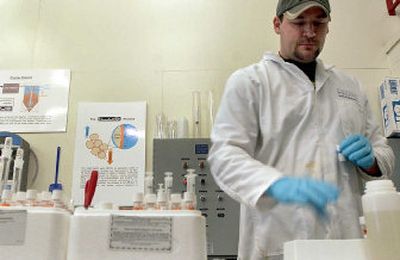Testing the waters is company’s mission

HAYDEN, Idaho – An automatic timer goes off at Hayden’s wastewater treatment plant: It’s time for a phosphorus screening test.
Despite their admirable qualities as stain-removal agents in dishwashing detergents and nutrients in fertilizers, phosphates aren’t welcome here. A federal permit allowing the Hayden plant to discharge treated wastewater into the Spokane River is up for renewal. When the new permit is issued, operators expect it to contain stringent new phosphorus standards, intended to curb the growth of algae blooms in the river.
That’s why the plant teamed with Blue Water Technologies Inc. The private firm is using the plant to test technology developed to scrub phosphorus from wastewater.
So far, results have been dramatic. Blue Water Technologies treats about one-quarter of the plant’s wastewater – about 250,000 gallons daily. Wastewater enters the plant with phosphorous levels at 7,000 to 10,000 parts per billion. After treatment, the levels drop to less than 10 parts per billion, according to company reports.
“We’re really pretty excited about it,” said Kent Helmer, interim operator for the plant, which is run by the Hayden Area Regional Sewer Board. “It could be something major for us.”
River health
The results come amid regional concern over the health of the Spokane River.
With population on both sides of the state line growing rapidly, local governments are busy planning for future sewer plant expansions. Phosphorus has emerged as a key permitting issue. Found in waste, fertilizers, detergents, pop, toothpaste and explosives, phosphorus acts as a nutrient in lakes and streams, spurring algae growth that robs the water of dissolved oxygen for fish. A well-fed adult consumes and excretes 1 to 3 grams of phosphorus a day in the form of phosphates.
The Spokane River is one of many water bodies with phosphorus problems. “We’re finding these hot spots all over the country,” said Tom Daugherty, Blue Water Technologies’ president.
In Helena, treatment plants are facing limits on phosphorus discharges into Prickly Pear Creek, part of the Missouri River watershed. In Arkansas, phosphorus levels have become an issue in Kings River, which flows north into Missouri. Each problem area represents potential markets, said Daugherty, who has lined up sales representatives covering 16 states.
Blue Water Technologies formed in 2003 as a spin-off of research done at the University of Idaho. This spring, Blue Water will make its first sale when it ships a $90,000 treatment system to an Indian casino near Edmonton, Alberta. The casino outgrew its septic system and needs sewer treatment to expand. The system will treat about 20,000 gallons of wastewater a day to start.
Daugherty said he’s also getting feelers from developers who can’t hook up to sewage systems. “It’s an economic issue for them,” he said. If the developments’ values are high enough, it might be worthwhile for the developers to build their own sewage treatment facilities, he said.
The firm, however, is just emerging from the research and development phase. Investors have sunk $2.5 million into Blue Water in its pre-revenue stage.
Blue Water Technologies has applied for a patent on its phosphorus removal system. Future research, also initiated by UI scientists, will focus on removing substances such as hormones and prescription drugs from the waste stream.
UI will receive royalties from the sale of the equipment. Three years ago, Blue Water received a license to commercialize the technology.
At the Hayden treatment plant, there’s plenty of raw material for future testing. The plant serves the Kootenai County Airport, the cities of Hayden and Hayden Lake and outlying areas. Blue Water Technologies has a 10-year contract, allowing the company to access as much as 1 million gallons of wastewater daily for research.
“It’s all about sewage,” Daugherty said.
b